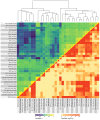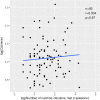Social and anxiety-like behaviors contribute to nicotine self-administration in adolescent outbred rats
- PMID: 30584246
- PMCID: PMC6305389
- DOI: 10.1038/s41598-018-36263-w
Social and anxiety-like behaviors contribute to nicotine self-administration in adolescent outbred rats
Abstract
Both emotional and social traits interact with genetic factors to influence smoking behavior. We previously established a socially acquired nicotine intravenous self-administration model where social learning of a nicotine-associated odor cue reversed conditioned flavor aversion and promoted nicotine intake. In this study, we first phenotyped ~800 adolescent heterogeneous stock rats in open field, novel object interaction, social interaction, elevated plus maze, and marble burying behaviors. These rats were then phenotyped on socially acquired nicotine self-administration. We found 243 significant correlations between different behavioral tests. Principal component regression analysis found that ~10-20% of the variance in nicotine-related measures, such as intake during the first or the last three fixed-ratio sessions, the progressive ratio session, and reinstatement behavior, can be explained by variations in behavioral traits. Factors corresponding to social behavior and anxiety were among the strongest predictors of nicotine intake and reinstatement of nicotine-seeking behavior. We also found many sex differences in behavioral measures. These data indicated that the genetic diversity of this population, in combination with social behaviour and anxiety, are significant contributors to the divergent nicotine self-administration behavior and indicated a high probability of discovering sex-specific genetic mechanisms for nicotine intake in future genome-wide association studies.
Conflict of interest statement
The authors declare no competing interests.
Figures






Similar articles
-
Propensity for social interaction predicts nicotine-reinforced behaviors in outbred rats.Genes Brain Behav. 2014 Feb;13(2):202-12. doi: 10.1111/gbb.12112. Epub 2013 Dec 27. Genes Brain Behav. 2014. PMID: 24289793 Free PMC article.
-
Social learning promotes nicotine self-administration by facilitating the extinction of conditioned aversion in isogenic strains of rats.Sci Rep. 2017 Aug 14;7(1):8052. doi: 10.1038/s41598-017-08291-5. Sci Rep. 2017. PMID: 28808247 Free PMC article.
-
Socially acquired nicotine self-administration with an aversive flavor cue in adolescent female rats.Psychopharmacology (Berl). 2016 May;233(10):1837-1844. doi: 10.1007/s00213-016-4249-2. Epub 2016 Feb 25. Psychopharmacology (Berl). 2016. PMID: 26911379 Free PMC article.
-
Cue dependency of nicotine self-administration and smoking.Pharmacol Biochem Behav. 2001 Dec;70(4):515-30. doi: 10.1016/s0091-3057(01)00676-1. Pharmacol Biochem Behav. 2001. PMID: 11796151 Review.
-
Neuropeptide systems and new treatments for nicotine addiction.Psychopharmacology (Berl). 2017 May;234(9-10):1419-1437. doi: 10.1007/s00213-016-4513-5. Epub 2016 Dec 28. Psychopharmacology (Berl). 2017. PMID: 28028605 Free PMC article. Review.
Cited by
-
Genome-Wide Association Study on Three Behaviors Tested in an Open Field in Heterogeneous Stock Rats Identifies Multiple Loci Implicated in Psychiatric Disorders.Front Psychiatry. 2022 Feb 14;13:790566. doi: 10.3389/fpsyt.2022.790566. eCollection 2022. Front Psychiatry. 2022. PMID: 35237186 Free PMC article.
-
The Wistar Kyoto Rat: A Model of Depression Traits.Curr Neuropharmacol. 2023;21(9):1884-1905. doi: 10.2174/1570159X21666221129120902. Curr Neuropharmacol. 2023. PMID: 36453495 Free PMC article.
-
Feature-aware unsupervised lesion segmentation for brain tumor images using fast data density functional transform.Sci Rep. 2023 Aug 21;13(1):13582. doi: 10.1038/s41598-023-40848-5. Sci Rep. 2023. PMID: 37604860 Free PMC article.
-
Genome-wide association study finds multiple loci associated with intraocular pressure in HS rats.Front Genet. 2023 Jan 30;13:1029058. doi: 10.3389/fgene.2022.1029058. eCollection 2022. Front Genet. 2023. PMID: 36793389 Free PMC article.
-
Sex differences in the elevated plus-maze test and large open field test in adult Wistar rats.Pharmacol Biochem Behav. 2021 May;204:173168. doi: 10.1016/j.pbb.2021.173168. Epub 2021 Mar 5. Pharmacol Biochem Behav. 2021. PMID: 33684454 Free PMC article.
References
-
- Eissenberg, T. & Balster, R. Initial tobacco use episodes in children and adolescents: current knowledge, future directions. Drug Alcohol Depend, 41–60 (2000). - PubMed
Publication types
MeSH terms
Grants and funding
- DA-026894/U.S. Department of Health & Human Services | NIH | National Institute on Drug Abuse (NIDA)/International
- DA-026894/U.S. Department of Health & Human Services | NIH | National Institute on Drug Abuse (NIDA)/International
- DA-026894/U.S. Department of Health & Human Services | NIH | National Institute on Drug Abuse (NIDA)/International

